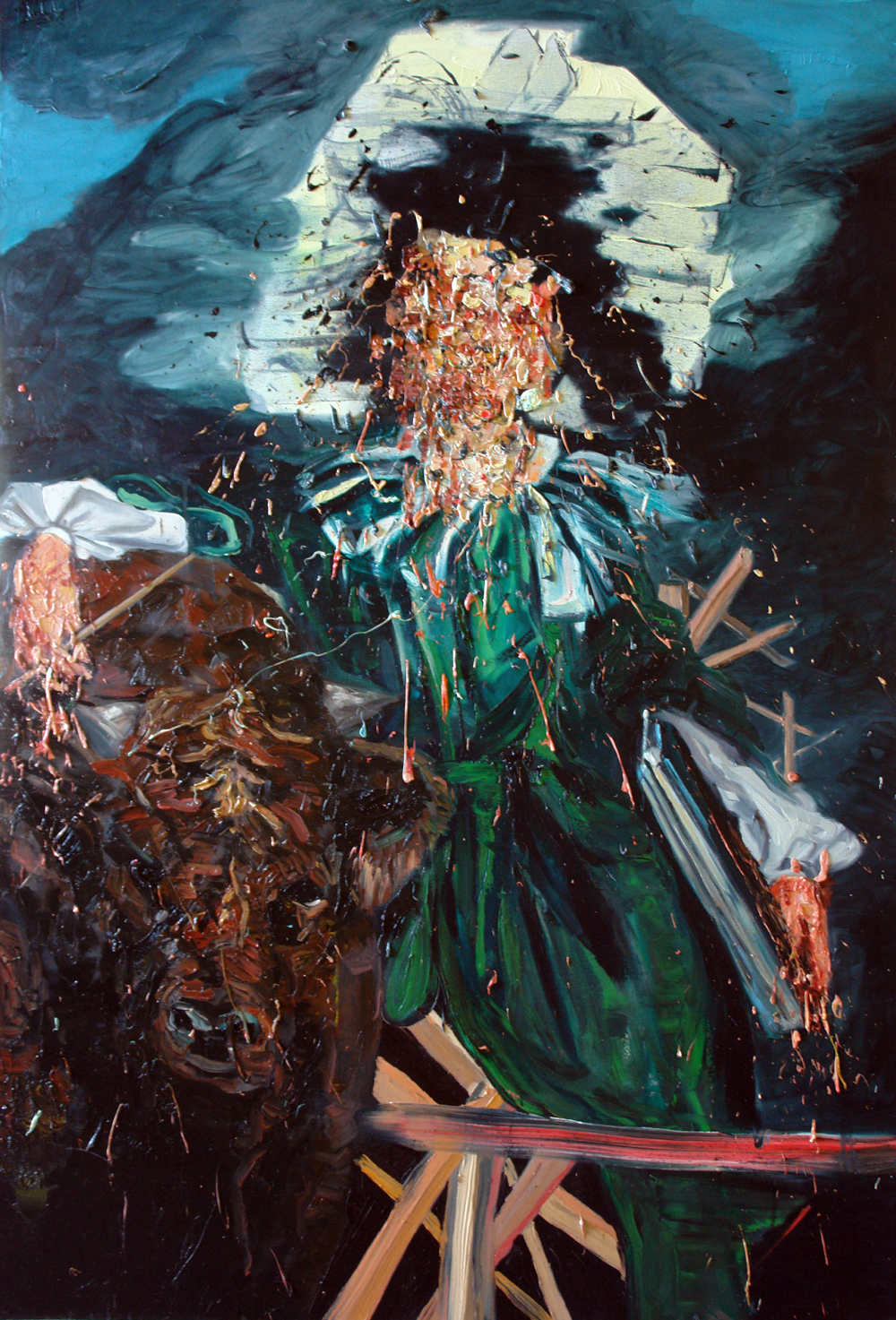Scott Taylor's "Rosa"
"Rosa" is an oil painting on canvas which, at 72 inches by 50, stands about as tall as an average human. The paint is handled with an exploratory brush which leaves some areas elevated and others flattened. Brushwork is evident and action based, though always seemingly in service of the image it depicts. The bulk of this image, in a classic portraiture composition, is occupied by an erect figure, which seems to be wearing a costume of the 19 th century. Thanks to the painting's title, we might safely assume this figure is Rosa. Her clothes are a modulated green, with a stark white collar and cuffs, and what looks like a massive black and white hat. Most jarringly, the figure's exposed face and hands seem to be in a simultaneous state of decay and explosion. No facial features are is discernable save a fleshy mass, which scatters bits of itself across the picture plane, emanating primarily outward and down.
Under the figure's right arm is a smallish bull, its front torso and head visible and facing forward toward the viewer. The animal is built up in brown and red strokes of paint and seems sanguine compared to the self-destructing Rosa. Under the figure's left arm is a book, and in her right hand is a pen or brush. Where Rosa's legs should be, instead protrudes a crudely constructed armature of wood, which can also be seen poking out from the region of her left shoulder. Behind the figure, a charged and darkened sky looms, with grey clouds pierced by brilliant cerulean blues. This background fades into a deep black, toward the painting's lower end, which obscures any landscape we can imagine.
By referencing old-master portraiture while painting in a very contemporary manner, Taylor is able to convey a sense of the changeability of the self in the path of progress. The figure in "Rosa" is melting, fraying and revealing her structural elements, less a fully realized person, like that which an old master might depict, than a shifting conglomeration of its constituent parts. In an era where we are increasingly leaving behind conceptions of the self as a holy and unitary "soul" in favor of mechanistic viewpoints, this portrait speaks volumes about the time in which we live. We are now generally believed to be built of cellular organization, chance life-experience and the impaction of our increasingly complex environment - how could we see ourselves as anything more stable than the erupting flesh-mask painted by Taylor?
In this vision, Taylor is keeping interesting company. Distantly, Soutine and Bacon's obsessions with rent flesh, perhaps as a charged symbol of the brutality of secular materialization in the body, may have informed his interests. More recently, the paintings of Dana Schutz seem to be working, at times, in a similar vein. In Schutz' epic work "Presentation", a crowd of onlookers prods the flesh of two exhumed bodies, similarly calling to question the new role of human-matter in a world much more interested in its own constructions than the sanctity of the nature.
Taylor's "Rosa", as I was informed after an email inquiry to the artist, is based on an Edouard-Louis Dubufe painting titled "Portrait of Rosa Bonheur". Rosa Bonhuer was a French Realist painter of the 19 th century. She primarily depicted scenes of nature and animals with an exhaustively patient and accurate hand. Perhaps, in choosing this subject, Scott Taylor is implicating himself in the painting as well, less repainting an image of Ms. Bonheur than composing a self-portrait as an artist undergoing an amplified questioning of the real .
In opposition to the venerating, positivist craft of the Realists, artists of today are faced with depicting humanity and the physical world under very different circumstances. Now, with a virtual reality brewing in circuits beneath us and quantum theory threatening even our most strenuously accurate physics, science does little to assure us of the veracity of our vision. By painting a portrait of a Realist artist in a state of what might be interpreted as psychedelic duress, we are given a glimpse of the instable ground on which Taylor, and many making art, currently stand. While nature, symbolized by the bull, remains as it always has been, our ability to see nature with clear eyes has gone. Perhaps in the poetic apocalypse of Rosa's scattering eyes, we will puzzle together something new, one day.
Max Razdow, Art and Then Ideas- 2006

Rosa, 2006 oil on canvas 72 x 50 inches